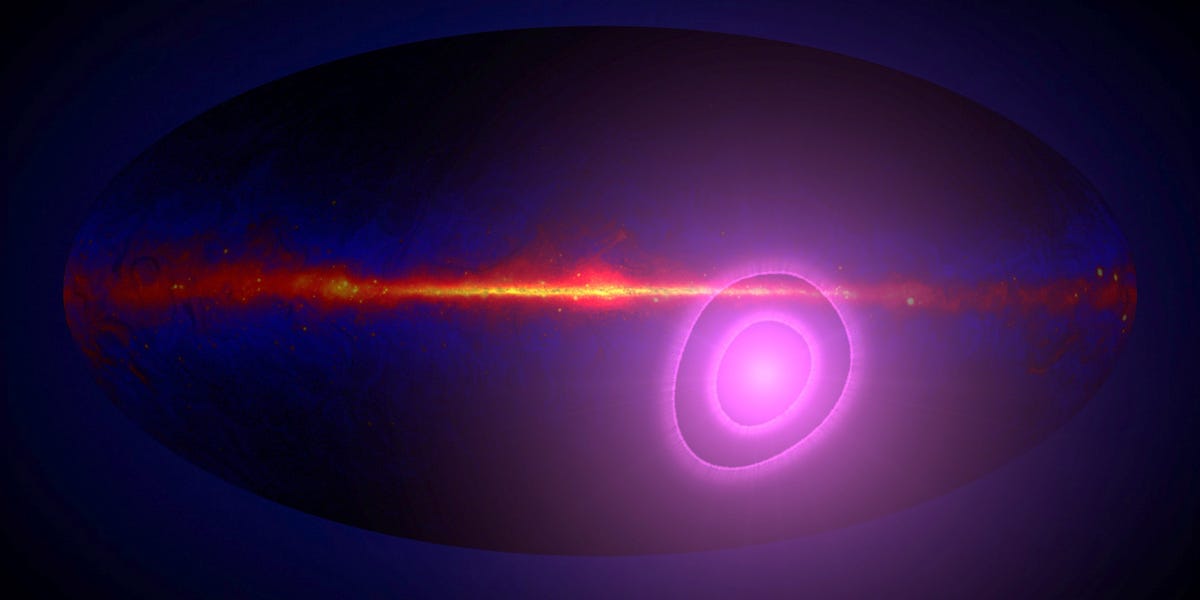I am not a physicist but this article is about background radiation and the study of it, and they found a lot of gamma radiation in a place they didn’t expect.
As usual, the editor of the article chose a title that could easily make a reader assume “…have they possibly found aliens??” when the truth is the scientists are very excited about needing to revise their understanding of cosmic background radiation. It seems purposable that the article was titled with the word “signal”, when the signal is a natural process, and then doesn’t bother to clarify that there is a near 0% chance this is a sign of intelligent life.
2/10 article, badly explained science writing.
This is seemingly ALL articles involving astronomy nowadays. It’s because nowadays, everyone is too busy trying to out-dank one another to be bothered with actual science.
And it suck’s because when people do actually read this nonsense- they’re left disappointed. It’s a cry wolf Situation.
It’s Business Insider
It’s gone so far down the drain it’s down in the gutter, drunk-fighting with the Daily Mail
My experience has taught me that any time I see a headline like this, it’s always a pulsar, or background radiation.
2024 Jan 14, 19:56 GMT by Polly Thompson
Nasa astronomers says signal coming from outside our galaxy is ‘unexpected and as yet unexplained’
NASA's Goddard Space Flight CenterNASA scientists have found a powerful new gamma-ray signal coming from outside our galaxy. They detected the alternative signal while looking for answers about the universe’s creation. The discovery has created a whole new cosmic conundrum for the astronomists.
NASA astronomers have discovered an unexpected “signal” coming from outside our galaxy, which they can’t explain.
The scientists were analyzing 13 years of data from the Fermi Gamma-ray Space Telescope when they noticed the mysterious signal.
It was “an unexpected and as yet unexplained feature outside of our galaxy,” wrote Francis Reddy of NASA’s Goddard Space Flight Center.
The powerful telescope can detect gamma rays, which are huge bursts of energetic light thousands to hundreds of billions of times as great as our eyes can see. They are often created when stars explode or a nuclear blast occurs. They stumbled on the alternative signal while looking for something else entirely.
“It is a completely serendipitous discovery,” said Alexander Kashlinsky, a cosmologist at the University of Maryland and NASA’s Goddard Space Flight Center, while presenting the findings to the American Astronomical Society.
“We found a much stronger signal, and in a different part of the sky than the one we were looking for.”
They had been searching for one of the oldest gamma-ray features for creating the first atoms — known as the cosmic microwave background or CMB.
The CMB has a dipole structure, where one end is hotter and busier than the other. Astronomers generally think our solar system’s motion creates the structure.
Instead, the researchers detected a signal coming from a similar direction and with a nearly identical magnitude as another unexplained feature, which had some of the most energetic cosmic particles they had ever detected.
“We found a gamma-ray dipole, but its peak is located in the southern sky, far from the CMB’s, and its magnitude is 10 times greater than what we would expect from our motion,” said Chris Shrader, an astrophysicist at Goddard.
This week, a paper describing the findings has been published in The Astrophysical Journal Letters.
They think the discovery could be linked to a cosmic gamma-ray feature observed by the Pierre Auger Observatory in Argentina in 2017.
The astronomers believe the two phenomena could originate from a single unidentified source, given their similar structure.
They hope to locate the mysterious source or develop alternative explanations for both features.
NASA’s unexpected discovery could help astronomers confirm or challenge ideas about how the dipole structure is created.
“A disagreement with the size and direction of the CMB dipole could provide us with a glimpse into physical processes operating in the very early universe, potentially back to when it was less than a trillionth of a second old,” said Fernando Atrio-Barandela, coauthor of the research paper.
...from the Fermi Gamma-ray Space Telescope
Okay, so, what they did observed was in the gamma ray spectrum. But now, they are talking about the cosmological microwave background (CMB) and signals from the big Bang at less than 1 second. Seems very surprising … and it seems to contradict the Big Bang Theory.… “We found a gamma-ray dipole, but its peak is located in the southern sky, far from the CMB’s, and its magnitude is 10 times greater than what we would expect from our motion,” …
Okay, maybe this time I get it : those dipoles, the one from the CBM and the one from the gamma spectrum, are analogs. So it implies that they would extend to the edges of the visible universe.
And since the limit of the visible universe is thought to be the origin of the Big Bang (because of this wrong theory) physicists are now confounded (like with many other recent observations).
The title could be a writing prompt.
It is, it’s called “Stargate: Universe”
Rescue science/space journalism!
original_sci._article_(harder_to_read)
Published 2024 January 10 OPEN ACCESS
Probing the Dipole of the Diffuse Gamma-Ray Background
The Astrophysical Journal Letters.Abstract
We measured the dipole of the diffuse γ-ray background (DGB), identifying a highly significant time-independent signal coincidental with that of the Pierre Auger UHECR. The DGB dipole is determined from flux maps in narrow energy bands constructed from 13 yr of observations by the Large Area Telescope (LAT) of the Fermi satellite. The γ-ray maps were clipped iteratively of sources and foregrounds similar to that done for the cosmic infrared background. The clipped narrow energy band maps were then assembled into one broad energy map out to the given energy starting at E = 2.74 GeV, where the LAT beam falls below the sky’s pixel resolution. Next we consider cuts in Galactic latitude and longitude to probe residual foreground contaminations from the Galactic plane and center. In the broad energy range 2.74 < E ≤ 115.5 GeV, the measured dipoles are stable with respect to the various Galactic cuts, consistent with an extragalactic origin. The γ-ray sky’s dipole/monopole ratio is much greater than that expected from the DGB clustering component and the Compton–Getting effect origin with reasonable velocities. At ≃(6.5–7)% it is similar to the Pierre Auger UHECRs with EUHECR ≥ 8 EeV, pointing to a common origin of the two dipoles. However, the DGB flux associated with the found DGB dipole reaches parity with that of the UHECR around EUHECR ≤ 1 EeV, perhaps arguing for a non-cascading mechanism if the DGB dipole were to come from the higher-energy UHECRs. The signal-to-noise ratio of the DGB dipole is largest in the 5–30 GeV range, possibly suggesting the γ-photons at these energies are the ones related to cosmic rays.
This “dipole of the diffuse γ-ray background (DGB)”, is aligned with the ultra-high-energy cosmic ray (UHECR) orientation.
https://en.m.wikipedia.org/wiki/Ultra-high-energy_cosmic_ray
deleted …






